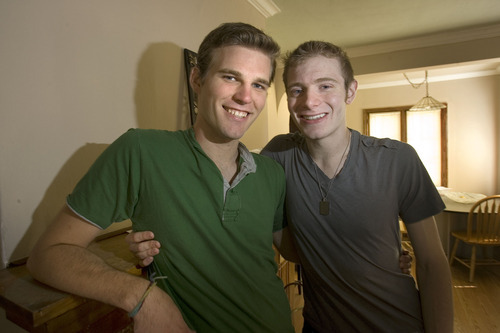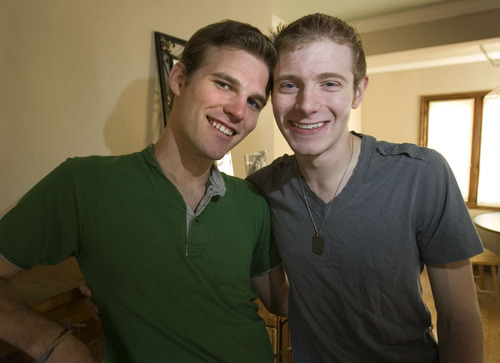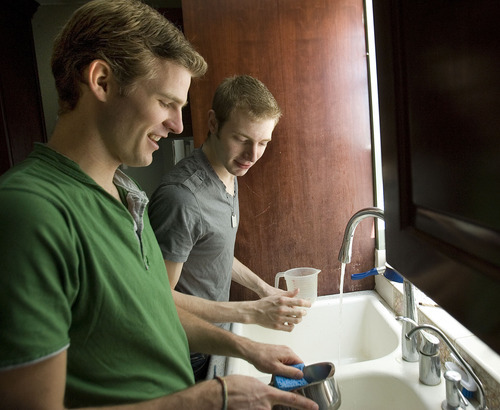This is an archived article that was published on sltrib.com in 2011, and information in the article may be outdated. It is provided only for personal research purposes and may not be reprinted.
To most of the world, Salt Lake City may be known for Mormons, skiing or maybe the Utah Jazz.
But one characteristic that the world, and even some residents, may not have guessed is this: Salt Lake City has the third-highest rate of same-sex couples among America's mid-size cities (those with populations between 100,000 and 250,000).
Salt Lake City — the capital of conservative Utah — ranks in the top 10 for same-sex couples with such well-known liberal places as Berkeley, Calif.; Cambridge, Mass.; and Madison, Wis.
"It doesn't surprise me," says Salt Lake City Mayor Ralph Becker. "I have known as mayor, and as anyone here who pays attention also knows, that we have a relatively large and active LGBT [lesbian, gay, bisexual and transgender] community."
A series of state-by-state data releases from the 2010 census containing data on same-sex couples was recently completed, allowing national comparisons. The Williams Institute at the UCLA School of Law used it to rank states, counties and cities. On the census form, a household head indicated that a second adult of the same sex is a spouse or an "unmarried partner."
Salt Lake City has 17.31 same-sex couples per 1,000 households, with 1,290 such couples overall. That is more than double the national rate of 7.7. (A decade ago in the 2000 census, Salt Lake City reported 10.87 same-sex couples per 1,000 households, and 777 couples overall.)
Gary Gates, a demographer who co-wrote the Williams Institute report, uses census data on same-sex couple households to estimate the size of the LGBT population. He predicts that about 8.5 percent of adults in Salt Lake City identify themselves as LGBT, compared with 3.8 percent of adults nationally.
Among large cities with populations of more than 250,000 people, San Francisco has the highest rate of same-sex couples at 33.41 per 1,000 residents, followed by Seattle at 25.54 and Oakland, Calif., at 24.61.
The proportion of households with same-sex couples in Salt Lake City is similar to that of Denver, Boston and even Manhattan, which has 19.32 per 1,000 households.
Utah overall ranked lower than average nationally: No. 32 among the states at 6.62 same-sex couples per 1,000 households.
"One of the reasons that, within Utah, Salt Lake City seems to have this high concentration is Utah really is a state that — outside of Salt Lake City — is very conservative. Salt Lake City serves as a real contrast in a political sense to the rest of the state," says Gates. "That could contribute to migration."
Cities like Salt Lake City, Denver, Atlanta and Minneapolis have a "regional draw" for LGBT people who are looking to live in a more accepting city without leaving their home state or region, Gates says. In the past, it was more common to move to San Francisco or New York, but now it's easier to find a welcoming climate closer to home, he adds.
Jakob Crawford, a 21-year-old gay man who lives in Salt Lake City, agrees.
"Gay people in Utah come to Salt Lake City because it's almost like an island of liberal progressives in a sea of conservative Mormon culture," he says. He attended high school in Salt Lake City, but he has met many who have moved to the capital from Payson, Price or Nephi.
Two years ago, Crawford's partner, Eric Hamren, moved from Northern California to Salt Lake City so the two could be together. They had met online after Hamren searched for another "gay Mormon" on MySpace. He discovered he was not alone. Both grew up in The Church of Jesus Christ of Latter-day Saints but left the faith after they came out.
"When I moved here, I was really surprised by how many LGBT people there were," Hamren, 22, says. "I felt safe in Salt Lake City. But anywhere outside of city boundaries, I didn't necessarily feel like I fit in."
Becker says he is glad that Salt Lake City is seen as welcoming to the LGBT community. During his term, the city became the first in Utah to create a mutual-commitment registry and to adopt ordinances that forbid housing and employment discrimination based on a person's sexual orientation or gender identity.
Crawford and Hamren appreciate those steps. They signed up on the mutual-commitment registry a year ago and have used it to ensure hospital visitation rights. Crawford carried the certificate in his hand when Hamren went to the hospital one night for abdominal pains.
"There's not a ton of rights that come with it, but we have the paper," Crawford says. "It feels good to be acknowledged as his partner."
Utah cities that have the highest rates of same-sex couples after Salt Lake City are South Salt Lake, 13.72 per 1,000 households; Millcreek, 11.66; Midvale, 10.74; and North Salt Lake, 9.81.
The highest rates among counties in Utah were: Salt Lake County, 10.08 per 1,000 residents; Summit, 9.29; and Weber, 6.26.
Places with higher rates of same-sex couples may also be places where people felt more comfortable reporting their relationship status to the census, Gates notes. A Williams Institute survey of gay and lesbian couples after the 2010 census indicates that about 10 percent did not identify themselves.









